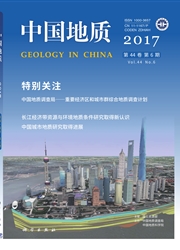

 中文摘要:
中文摘要:
东波超镁铁岩体位于雅鲁藏布江缝合带的西段,在中国是一个不多见的面积超过400 km2的大型超镁铁岩体。已有的岩石学和矿物学特征表明,该岩体与同一带中含有大型铬铁矿的罗布莎岩体可以对比,是一个寻找铬铁矿床的远景区。本文开展了东波超镁铁岩的主要组成岩石类型——方辉橄榄岩的铂族元素(PGE)研究,并结合主量和稀土元素(REE)组成,探讨岩体的成因。东波超镁铁岩中方辉橄榄岩具有相当高的Os含量(3.52×10-9~4.36×10-9),亏损的主量元素组成和低于原始地幔的稀土元素含量(0.89×10-6~1.37×10-6),指示东波超镁铁岩为经历过部分熔融和熔体抽取的亏损残余地幔岩石。东波超镁铁岩的PGE总含量为23.97×10-9~31.98×10-9,高于原始地幔的含量;PGE配分型式为左倾的正斜率型,相对Ir亚组铂族元素(IPGE)亏损钯亚组铂族元素(PPGE),Pd/Ir=1.49~2.65;REE配分型式为中稀土亏损的“V”型或“U”型,原始地幔标准化元素比值(La/Sm)m 为 1.05~3.37,(Gd/Yb)m=0.28~0.64;这些数据揭示东波超镁铁岩经历过交代作用,交代物质应富集不相容元素,高PGE含量,相对IPGE富集PPGE;较低的Cu/Pd比值(1226~3448)要求交代物质还应富含硫化物;推测交代物质可能来源于俯冲带构造环境下所产生岩浆熔离出的富硫化物熔体/流体。
 英文摘要:
英文摘要:
Located in the western part of the Yarlung Zangbo suture zone, the Dongbo ultramafic rock massif is comparable with the Luobusa ultramafic rock massif which holds the largest chromite deposit in China in terms of their petrology and mineralogy. In this paper, the authors attempted to characterize its origin by examining the geochemistry of platinum group elements (PGE), major elements and rare earth elements (REE) of the harzburgites which are the main rocks of the rock mass. The harzburgites are characterized by high abundances of Os (3.52×10-9~4.36×10-9), depleted major element compositions and low REE content (0.89×10-6~1.37×10-6) which is lower than that of the primary mantle, indicating that the Dongbo ultramafic rocks belonged to depleted residual mantle rocks after a significant degree of partial melting and melt extraction. They also have high PGE content (23.97×10-9~31.98×10-9) which is higher than that of primary mantle, and display IPGE-depleted, PPGE-enriched chondrite- and primary mantle- normalized PGE patterns with Pd/Ir being 1.49~2.65. Their chondrite- and primary mantle-normalized REE patterns are all U- or V-shaped with (La/Sm)m being 1.05~3.37 and (Gd/Yb)m 0.28~0.64 (primary mantle-normalized values). These features are consistent with the opinion that the Dongbo ultramafic rocks were formed by the interaction of depleted residual mantle rocks with melts/fluids which were enriched with incompatible elements and PGE, especially IPGE relative to PPGE. In addition, the low Cu/Pd ratios (1226~3448) argue that the melts/fluids should also have high content of sulfides. The authors infer that the melts/fluids that reacted with the residual mantle rocks probably originated from the magmas produced in a subduction-related tectonic setting.
 同期刊论文项目
同期刊论文项目
 同项目期刊论文
同项目期刊论文
 期刊信息
期刊信息
